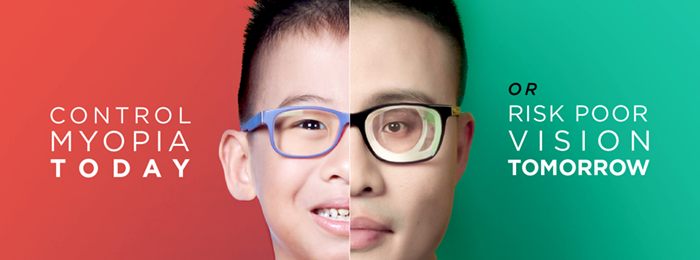Waking Up to the Wonders of Ortho-K

There is a somewhat unconventional but increasingly popular method of treating myopia called Orthokeratology – or Ortho-K for short. It involves wearing specially designed contact lenses overnight, which temporarily reshapes the surface of the eye. Find out more about this ‘quiet achiever’ of myopia control.
WHEN, WHO, WHAT
Orthokeratology has been employed since the early 1940s through to the 1960s in the United States. George Jessen, an Optometrist who was an early pioneer of the contact lens, is also credited with being one of the first to employ the concept of Orthokeratology in its earliest form.
By definition, Orthokeratology is the temporary reduction of myopia achieved by the programmed application of contact lenses to reshape the cornea. Modern orthokeratology uses specially designed reverse geometry gas permeable (GP) Ortho-K shaping lenses that are worn when the patient sleeps. Some myopic patients, after a night of wearing such lenses, enjoy near-perfect vision without glasses for the whole of the next day.
WHY YOU OUGHT TO CONSIDER ORTHO-K
Ortho-K lenses are able to correct myopia better than regular soft contact lenses and seldom trigger the allergies, dryness and irritation that are associated with several hours of wearing regular contact lenses. If used properly, Ortho-K contact lenses carry a lower risk of developing eye infections than conventional contact lenses.
Furthermore, Ortho-K lenses are on a par with atropine drops for controlling the axial length elongation of the eyeball and the stabilisation of myopia progression. Most importantly, Ortho-K lens users do not suffer from photophobia (light sensitivity) and a long list of other complications which are associated with atropine drops.
Compared to lenses with addition (PAL or Bifocals), Ortho-K lenses are considered the more effective and intensive method of myopia control as the lenses are centred on the eye instead of on the face. Perhaps the main advantage of Ortho-K lenses is that the treatment lenses are not affected by the movement and focusing of the spectacles on the face.
CANDIDATE? CAN!
In general, children are the best candidates for Ortho-K lenses. Ideally, the child should be between six and 14 years old, with myopia between -1.00DS and -5.00DS. Other factors that an Optometrist will consider before prescribing Ortho-K lenses are whether the child plays sports, whether he or she dislikes wearing glasses, and how often the child’s pair of glasses needs to be changed. The motivation of both child and parent to wear the lenses and their commitment to lens care are also assessed.
WORKING WHILE SLEEPING
During sleep, Ortho-K contact lenses gently reshape the front surface of the cornea, which is soft and able to be subtly moulded. The lenses float on the eye tear film, yet provide enough pressure to reshape the cornea. When the lenses are removed in the morning, the change in the curvature of the corneal surface results in clear vision during waking hours, thus reducing the need for wearing contact lenses or glasses during the day.
The success rate of Ortho-K lenses is very high. Many Optometrists report 6/6 vision in over 90% of their patients, similar to Lasik surgery. Results, however, depend on the patient’s original prescription, treatment goals, compliance, motivation levels and how the patient’s individual eyes respond. A comprehensive exam conducted by an Optometrist who is conversant with Ortho-K will provide a better picture of the probability of success.
In the majority of cases, vision improvement starts after one night of wear. Some patients notice it within a few hours, and it is significant within two hours. Vision is normally good during all waking hours within the first week. Since children’s eyes are more easily moulded than adults’, results are generally faster and better in young patients than they are in adult ones. However, some individuals’ eyes do not respond to the original design as expected, in which case the Optometrist will need to change the design to achieve optimal results.
While Ortho-K does not result in permanent vision correction, it does slow down myopia progression, which significantly reduces the severity of the myopia when the child’s eye ceases to grow at around the age of 20. In the sensitive tween and teen years, it can also liberate your child from the stigma and inconvenience of wearing glasses.
FOCUS ON YOUR CHILD’S TREATMENT OPTIONS
Clearly, Ortho-K is a treatment option worth considering. If you would like more information on this promising form of treatment, or wish to have your child assessed for his or her suitability, visit the Myopia Control Centre at W Optics, Suntec City. A team of Optometrists who specialise in childhood myopia are on hand to provide unbiased advice on treatment options and plans.
Visit https://www.essilor.com.sg/w-optics to find out more about childhood myopia treatment options.
Disclaimer: Myopilux lenses and Orthokeratology may not be able to address individuals’ conditions due to natural deficiencies, illnesses, pre-existing medical conditions and/or advanced age of consumers. The information contained herein is general information and is not and not intended to constitute medical advice. Please consult an eye care professional at W Optics for more information prior to the use of Myopilux or Orthokeratology.

